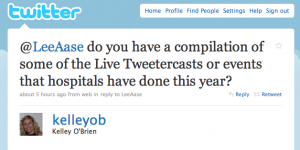American Medical News has a nice profile this morning of Dana Lewis, who exemplifies the new role, in an article titled “Hospitals’ new specialist: Social media manager.” The article begins:
For otolaryngologist Douglas Backous, MD, Twitter and blogging were “like speaking a foreign language.” So he went to his hospital and got himself a translator: Dana Lewis, hired by Seattle’s Swedish Medical Center to handle all things social media.
Lewis is part of a trend in a new and growing type of hospital employment: the social media manager.
Technically, she’s called the interactive marketing specialist. But she, and others like her, are being charged by their hospitals to handle such duties as overseeing their social media presence, communicating with patients through social media — and, in many cases, teaching affiliated or employed physicians how to use social media. The idea is that by having a person dedicated to social media, the hospital can use the technology to strengthen its connections with all of what organizations like to call their stakeholders, which include the physicians who refer patients through their doors.
Check out the whole article: Ed Bennett’s Hospital Social Networking List also is featured, as are my 35 Theses here on SMUG. It also has a nice compilation of social media best practices for hospitals, which author Bob Cook apparently synthesized from several guidelines documents.
Here’s more information on what we’re doing at Mayo Clinic, with our new Center for Social Media. I’m excited that we’ve hired candidates for four of the eight new positions with the Center, and that we have interviews this week and next for two more. I’m also honored that both Ed and Dana are on our advisory board (with 12 more members still to be named). We’re going through about 120 applications from some really strong candidates to ensure broad-based and diverse membership.
When the official online publication of the American Medical Association devotes an extensive article to the topic of social media staffing for hospitals, that’s a good sign the activity is going mainstream. We’re glad to contributing to that through the Mayo Clinic Center for Social Media and the Social Media Health Network.
